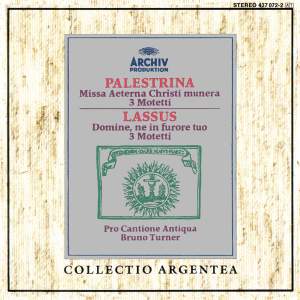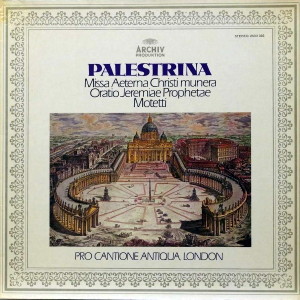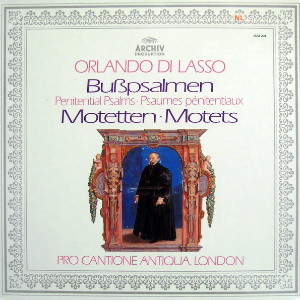 |
|
1 CD -
437 072-2 - (c) 1986
|
 |
| 1 LP -
2533 322 - (p) 1976 |
 |
| 1 LP -
2533 290 - (p) 1975 |
|
| PALESTRINA
& LASSUS |
|
|
|
|
|
| Giovanni Pierluigi da
Palestrina (ca. 1525-1594) |
|
|
| Missa "Aeterna
Christi munera" |
|
|
| - Kyrie |
2' 33" |
|
| - Gloria |
3' 28" |
|
| - Credo |
5' 55" |
|
| - Sanctus |
4' 38" |
|
| -
Agnus Dei |
4' 50" |
|
| 3 Motets |
|
|
| - Sicut cervus
desiderat |
3' 22" |
|
| - Super flumina
Babylonis |
4' 42" |
|
| - O bone Jesu |
3' 31" |
|
|
|
|
| Orlande de
Lassus (ca. 1532-1594) |
|
|
| 3 Motets |
|
|
| - Ave Regina
caelorum |
2' 58" |
|
| - Salve Regina |
4' 00" |
|
| - O mors, quam
amara est |
6' 15" |
|
| Domine, ne in
furore tuo - First
Penitential Psalm |
15' 48" |
|
|
|
|
| PRO CANTIONE ANTIQUA
/ Bruno Turner, Direction
|
INSTRUMENTALISTS |
|
| - Keith Davis, Countertenor |
- Roderick Skeaping,
Treble viol *
|
|
| - Paul Esswood, Countertenor |
- Trevor Jones, Tenor
viol * |
|
| - Kevin Smith, Countertenor |
|
|
- James Bowman, Countertenor
*
|
HAMBURGER
BLÄSERKREIS FÜR ALTE MUSIK
|
|
| - Jemes Griffett, Tenor |
- Ulrich Brandhoff,
Cornett * |
|
| - Ian Partridge, Tenor |
- Fritz Brodersen, Alto
trombone * |
|
| - James Lewington, Tenor |
- Hans von Busch, Tenor
pommer * |
|
- Ian Thompson, Tenor
*
|
- Hubert Gumz, Tenor
trombone * |
|
| - Brian Eyheridge, Bass |
|
|
| - David Thomas, Bass |
|
|
- William Mason, Bass
*
|
|
|
- Mark Brown, Bass
*
|
|
|
- Michael George, Bass
**
|
* Lassus only / **
Palestrina only |
|
|
|
|
|
Luogo
e data di registrazione |
|
-
Friedrich-Ebert-Halle,
Hamburg-Harburg (Germania) -
maggio 1974 (Lassus)
- All Saint's Church, Petersham
(Inghilterra) - agosto 1974
(Palestrina) |
|
|
Registrazione:
live / studio |
|
studio |
|
|
Producer /
Engineer |
|
Andreas
Holschneider (Lassus) - Gerd
Ploebsch (Lassus) - Mark Brown
(Palestrina) / Wolfgang Mitlehner
(Lassus) - Tony Faulkner
(Palestrina) |
|
|
Prima Edizione
LP |
|
-
Archiv - 2533 322 - (1 lp) -
durata 43' 43" - (p) 1976 -
Analogico - (Palestrina -
parziale)
- Archiv - 2533 290 - (1 lp) -
durata 54' 33" - (p) 1975 -
Analogico - (Lassus - parziale)
|
|
|
Edizione
"Collectio" CD |
|
Archiv
- 437 072-2 - (1 cd) - durata 62'
16" - (c) 1986 - ADD |
|
|
Note |
|
- |
|
|
|
|
PALESTRINA
· LASSUS: SACRED WORKS
Palestrina
was born about 1525,
probably in the little town
of the same name in the
hills east of Rome, Lassus
some seven years later in
Mons, the capital of the
county of Hainault, then
part of the Emperor Charles
V’s possessions in what is
now Belgium. Both achieved
international renown as
early as the middle 1560s,
and both died within a few
months of one another in
1594 - Palestrina in Rome
and Lassus in Munich, where
he had served the ducal
court of Bavaria for nearly
40 years. Both are, as it
were, musical grand-children
ofthe great Josquin
Desprez, yet each exploits a
different aspect of his
multi-faceted art:
Palestrina the
plainsong-saturated lyrical
counterpoint of his later
works, Lassus his energetic
rhythms, harmonic drive and
vivid expressiveness. It is
natural to see some of this
difference in terms
of the age-old contrast
between northern and
southern traditions, but
some of it must surely come
from differences of
temperament, formed by two
very different careers.
Palestrina received his
early training as a choirboy
in Rome at the basilica of
S. Maria Maggiore. A few
years as organist in his
home town then enabled him
to refine his skills in a
backwater, but also brought
him the powerful patronage
of the local bishop, who was
elected pope as Julius III
in 1550. Within a year
Palestrina was back in Rome,
first
as choirmaster of the
Cappella Giulia at St.
Peter’s, and then
(irregularly, since its
statutes debarred married
men) as a member of the
still more prestigious
Cappella Sistina, the pope’s
personal choir. When Paul IV
succeeded Palestrina’s
patron, after the very brief
reign of Marcellus II, he
enforced the rules more
strictly, and Palestrina had
to move to the musically
less rewarding basilica of
St. John
Lateran, but for the last 20
years of his life he settled
at the Cappella Giulia once
more.
It would be easy to present
the aspects of Palestrina’s
music that appealed to the
prelates of
counter-reformation Rome in
purely negative terms: it
never obscures clear
declamation of the text, yet
never sacrifices musical
good manners to detailed
illustration or vivid
expression of that text.
This would be to miss the
positive quality of radiant
serenity that Palestrina’s
music embodies, particularly
in his more than a hundred
settings of the mass. Aeterna
Christi munera is
based on a hymn in honour of
the Apostles whose melody,
at least in the version
Palestrina knew, is of
almost folksong-like
simplicity. But there is
nothing simple about the
way in which he takes
advantage of its emphasis
on the first,
third, fifth, and
eventually sixth degrees
of the major scale;
without any literal
repetition every section
exploits this sense of
confident upward movement.
Within this placid context
such touches as the
harmonic colour at “ex
Maria virgine” or the
rising bass scale at
“vivos” (both in the
Credo) tell immediately,
as does the warmth of an
extra tenor part in the
final Agnus Dei and the
archaic “fauxbourdon”
sound of the parallel
sixth-chords at “dona
nobis pacem”. Although
there is much uncertainty
about the dating of
Palestrina’s masses, there
is no reason to think that
this one was composed much
before he published it in
1590; this is the
simplicity of ripeness,
not inexperience.
Of
the three motets on this
recording, none is
strictly speaking
liturgical, so all are
freely composed, without
reference to a
pre-existing plainchant. Sicut cervus
(its livelier second part
is omitted here) and Super
flumina,
both with texts from the
Book of Psalms and both
published in 1584, are
perfect examples of
Palestrina’s restrained
pathos. In the former the
emphasis is on elegantly
balanced lyricism; the
latter, with its evocation
of the Babylonian exile,
contains some more overtly
rhetorical touches, as at
the chordal setting of
“illic sedimus”. O
bone Jesu, whose
non-biblical text belongs
to the realm of personal
devotion, is much more
homophonic in style; it is
probably the earliest of
these pieces, for it was
published in 1575.
Two things distinguish
Lassus among the great
composers of the high
Renaissance: his
extraordinary creativity
(his list of individual
compositions runs to
something like 2000) and
his equally extraordinary
diversity. Fluency is
natural in any genius born
into a thriving tradition,
of course; Lassus’s native
territory had supplied
Europe with some of its finest
composers for three
generations and more. We
can assume that his early
training at the church of
St. Nicholas in Mons was
thorough, even though he
was not able to enjoy it
for long. At the age of
about twelve or fourteen
he was recruited into the
service of Ferrante
Gonzaga, the Duke of
Mantua’s younger brother
and the Emperor’s
commander-in-chief- also a
keen music-lover who
maintained his own chapel.
As soon as his military
duties in the Low
Countries were hnished,
Ferdinando set off for
Sicily, where he was the
Imperial Viceroy. Lassus
was thus plunged at an
unusually early age into
the most dynamic and
cultivated artistic
environment in Europe. He
stayed in Italy some nine
or ten years, at Palermo,
Milan, Naples and finally
Rome, where he was
appointed choirmaster at
St. John Lateran in his
early twenties. After two
years in Rome he received
word that his parents were
ill; he hurried north once
more, but both were dead
on his arrival.
Talent gravitates towards
prosperity, and for the
next year or two we find
Lassus at Antwerp, a
centre of the new trade of
music-publishing. Here he
attracted the attention of
Duke Albrecht of Bavaria’s
agent, and probably in the
autumn of 1556 he moved to
Munich, which was to be
his home for the rest of
his life. But his early
travels had already marked
him with his chameleon
gift of mimicry: the
volume he brought out with
the Antwerp printer Susato
contained serious and
popular Italian madrigals,
French chansons, Latin
motets both sacred and
secular. Throughout his
Munich years he continued
to compose in all these
genres, even adding to
them that of the German
secular song, but this
recording is concerned
only with that part of his
output (by far the
largest) which was devoted
to the church.
The earliest surviving
edition of his famous
setting of the Penitential
Psalms (from which Domine,
ne
in furore tuo comes)
was published in Munich in
1584, but that is not the
date of the psalms
themselves: Lassus’s
dedicatory letter tells us
that they had been
composed some 25 years
previously and reserved
for the Duke’s private
use. Albrecht was keenly
interested in the movement
for the reform of Roman
Catholic church music, at
a time when the whole
existence of polyphony was
threatened (not for the
first or the last time) by
radical members of the
clergy. The matter came up
for discussion at the
Council of Trent during
1562-63, with further
deliberations by a
commision of cardinals in
Rome during the two
following years. Lassus’s
recently composed settings
of the Penitential Psalms
represent the ideal of a
purified polyphony that
helped Albrecht and his
party to carry the day. O
mors,
quam amara est was
first published in Paris
in 1564; it shares with
the Penitential Psalms its
air of sober, not to say
sombre, reflection (the
grimly moralizing text is
taken from Ecclesiasticus
41, 1-4) but its six
voices give Lassus more
scope for textural and
rhythmic variety.
The two remaining pieces
on this recording, both
Marian antiphons, were
composed some twenty years
later, to judge by the
dates at which they were
copied into the Munich
chapel choirbooks. Both
show Lassus in a freer,
less austere guise;
neither quotes the
well-known plainsong
melodies, though he makes
use of those in other
settings. Ave Regina
caelorum is an
exquisite miniature for
four voices. Salve
Regina is utterly
different in character,
rich and homophonic where
the other is transparently
contrapuntal. Lassus
divides his six voices
here into blocks of
contrasting sound, very
much in the Venetian
manner (he was well
acquainted with both the
Gabrielis). Here too there
are touches which we might
almost regard as
“madrigalisms”: the run on
“vita”, the caught breath
before “suspiramus”,
above all the melodic
inflections that underline
the pathos of words
like “lacrimarum” and
“misericordes” with the flat
sixth degree (E flat), and
the sweetness of “dulcis
virgo Maria” with a shift
from B flat
to B natural.
Jeremy
Noble
|
|